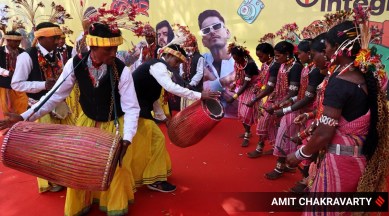📣 For more lifestyle news, click here to join our WhatsApp Channel and also follow us on Instagram
In pictures: The fascinating tattoo culture of women from the Baiga community
The Baiga community recently performed their traditional dance Karma at a festival in Mumbai

India is a land of diversity with each part of the country having beautiful, distinct cultural traditions of their own. One such is the traditional dance of the Baiga community. The Baigas are an ethnic group found in central India, in the states of Madhya Pradesh, and also scattered in parts of Uttar Pradesh, Chhattisgarh and Jharkhand.
The community showcased their traditional dance recently at Kula – A Global Gathering in Mumbai. The dance, which is called Karma, is performed on the auspicious occasion of Dussehra.
monthly limit of free stories.
with an Express account.
The men and women adorn their festive attire for the dance with women wearing seven-meter long hand spun sari-like drapes made of cotton, and the men wearing silken cotton wraps. Both also wear headgear with floral motifs and silver jewellery. The festive folk songs are sung in the local Gondi language. The songs are also accompanied by the menfolk playing drums.
Hosted in the Nesco Exhibition Ground in Goregaon, the event saw more than 150 artistes in attendance, showcasing their skills in dance, folk art, music, tattooing and more.
But what sets apart the Baiga people, especially the Baiga women, are the tattoos that cover their whole bodies. We spoke to Mangla Bai, a tattoo artist who resides in Dindori district of Madhya Pradesh, and is currently in Mumbai for the festival. She has a stall at the Kula festival where she is making tattoo designs for visitors. “The Baiga people have been tattooing since pre-historic times even before modern culture and civilisation existed,” she said.
Recalling that back in the days, ink from the local trees was used to design the tattoos, she expressed, “We are very connected to nature, so all our designs are also inspired by nature”.
Honouring their love for mother nature, the tattoo designs range from fish, leaves, and animals. “All the women of the community are tattooed. When girls turn nine years old, they get their first tattoo,” Mangla Bai mentioned. “Usually the first tattoo is on their forehead and then hands, legs and back until their whole body is covered with this art. Back in the day, our community didn’t have clothes or houses, but we always had our tattoos,” she added.
📣 For more lifestyle news, follow us on Instagram | Twitter | Facebook and don’t miss out on the latest updates!
📣 For more lifestyle news, click here to join our WhatsApp Channel and also follow us on Instagram